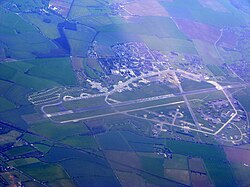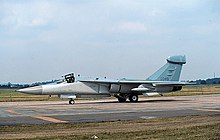RAF Upper Heyford
| RAF Upper Heyford | |
|---|---|

|
|
| Characteristics | |
| ICAO code | EGUA |
| IATA code | UHF |
| Coordinates | |
| Height above MSL | 132 m (433 ft ) |
| Transport links | |
| Distance from the city center | 8 miles northwest of Bicester |
| Street |
|
| Basic data | |
| opening | 1918 |
| closure | 1994 |
| operator | United States Air Force (last) |
| Start-and runway | |
| 09/27 | 2530 m of asphalt |
The Royal Air Force Station Upper Heyford , RAF Upper Heyford for short , was a military airfield last used by the United States Air Forces in Europe (USAFE) in the United Kingdom northeast of the town of Upper Heyford, located between Bicester and Banbury in Oxfordshire , South East England . At the height of the Cold War , the base was one of two European bases for General Dynamics F-111 heavy fighter-bombers, along with the RAF Lakenheath base further east .
The site is now used for civil, commercial and residential purposes, and some of the 54 Hardened Aircraft Shelters were added to the English Heritage List in 2011. The former barracks area is now referred to as Heyford Park.
history
Upper Heyford Airfield was built for the Royal Flying Corps (RFC) during the First World War , but was only used for flying by the new Royal Air Force from July 1918 .
In the interwar period and during the Second World War , RAF Upper Heyford then served in particular as a training ground for the 2nd Group and between March 1946 and June 1950 the station was finally home to the No.1 Parachute Training School .
With the beginning of the Cold War, the United States Air Force took over the base in 1950 and expanded it from the middle of the year. The following year it was initially subordinated to the Third Air Force , part of the United States Air Forces in Europe (USAFE), but came under the control of the Strategic Air Command (SAC) in early 1952 and became a base for bombers and reconnaissance aircraft.
In the summer of 1965 RAF Upper Heyford came back under the control of the USAFE and in 1966, when France left the military structures of NATO, it became the base of the 66th Tactical Reconnaissance Wing (66th TRW), which was previously located at Laon-Couvron Air Base . At that time it was equipped with the RF-101 and received the RF-4C from 1969
In the following year, the 66th TRW was inactivated and Upper Heyford became home to the 20th Tactical Fighter Wing (20th TFW) from RAF Wethersfield . This went hand in hand with the conversion of the 20th TFW to the F-111E, the first of which arrived in September 1970. It was the first F-111 formation in Europe and flew the F-111 from 1971 to 1993 just before the base was closed (The other F-111 formation in Europe was the 48th TFW at RAF Lakenheath .) In addition to three squadrons of F -111E, the squadron temporarily operated an EF-111A squadron from February 1984.
Aircraft from Upper Heyford carried out Operation El Dorado Canyon in April 1986 with the F-111Fs of the 48th Squadron from RAF Lakenheath .
Machines moved to Turkey for practice in 1990 and then flew combat missions in the Second Gulf War in 1991 . With the end of the Cold War, the squadron, which was renamed the 20th Fighter Wing in 1992, was decommissioned. The last three F-111s left Upper Heyford on December 7, 1993 and the airfield was closed on the 15th of the same month. Some F-111s from the 20th TFW have survived in museums. The 20th Squadron was then reorganized in Shaw AFB .
A rearguard of the USAFE returned the base to the British at the end of September 1994, but they no longer had any military use for them.

